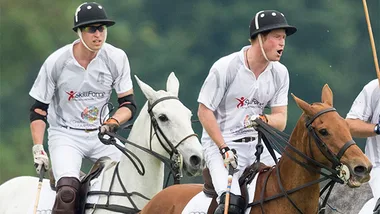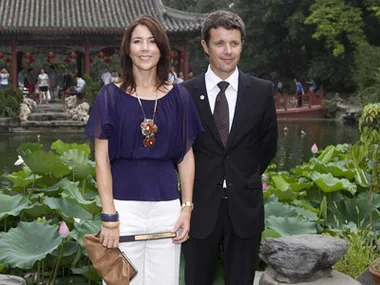Aristocratic blood doesn’t come much bluer than Anne Glenconner’s.
She was born Lady Anne Veronica Coke, eldest child of the 5th Earl of Leicester, her family established in Tudor times, and raised at Holkham Hall.
This massive stately pile in the county of Norfolk is the fifth largest estate in England and just ten miles from Sandringham, the royal family’s private home.
As a young girl, Anne’s playmates were Princesses Elizabeth and Margaret and as a teenager Prince Charles became “like a younger brother”, sharing happy afternoons mucking around on the local beach.
Now 87, she’s ready to reflect on incredible times gone by in a revealing and sporadically shocking autobiography, Lady in Waiting: My Extraordinary Life in the Shadow of The Crown.
The book is courageous, candid, very personal and something of a love letter to her friend Princess Margaret, who Anne believes has been unfairly maligned since her death.
“I think I have redressed some of the very trashy things that have been said about her by people who don’t know her,” Anne says.
“I wanted to because I really loved her. She was so much a part of my life, and having also lived with her at Kensington Palace for a whole year, I got to know her really very well.”
Anne was aged two or three when she first met the two princesses. They regularly visited Holkham where Anne and Princess Margaret would dash around the labyrinthine corridors.

Actress Vanessa Kirby played Princess Margaret in the Netflix series The Crown.
(Credit: Supplied)“Princess Margaret was such fun, quite naughty and she and I got on so well. Occasionally I heard the Queen [as she became] saying, ‘What are you doing?'” remembers Anne, laughing.
There’s a photograph from around this time which Anne loves.
“We are all standing in a line. Princess Elizabeth is frowning at Princess Margaret, suspecting she is up to no good, while Princess Margaret is staring down at my shoes.
“Years later I asked Princess Margaret what she was looking at. ‘Well, I was so jealous because you had silver shoes and I had brown ones’ she said.”
We are talking at Anne’s flat in London. In her rarefied orbit of nannies, debutante balls and weekend shooting parties – an annual highpoint at Holkham – girls were trapped in a gilded cage, their sole aim to marry well.

Princess Elizabeth (centre) frowning at Princess Margaret admiring Anne’s shoes.
(Credit: Photo supplied.)For Anne’s father, having three daughters was “the biggest disappointment of his life” and they knew it.
Anne recalls “the thrill of my mother having another baby when I was 12 and my aunt ringing up the school, saying, ‘Your mother has had a darling little baby girl’. We just burst into tears. We knew how sad my father would be, and my mother, too.”
In her hallway Anne proudly shows me a painting of the Queen’s coronation in 1953. It depicts Westminster Abbey packed to the rafters, a moment frozen in time.
The Queen is in her famous ornate coronation gown, created by fashion designer Norman Hartnell, watched by a four-year-old Prince Charles pinned between the Queen Mother and Princess Margaret.

Anne (third from left) with Queen Elizabeth II and her Maids of Honour after her Coronation in 1953.
(Credit: Getty Images)On the floor of the Abbey is Anne, a willowy not quite 21-year-old in a dreamy ivory silk gold embroidered sleeveless gown, one of the six trembling matrons of honour.
Being part of that historic occasion was a heart-pumping experience – especially when Anne started to sway and almost fainted, saved by the Gentleman Usher of the Black Rod (the monarch’s representative in the House of Lords) and a handy pillar.
Anne was one of an elite handful to witness the sacred anointing of the new Monarch with holy oils.
“I realised what an extraordinary moment it was. She gave herself to the Commonwealth and Great Britain and to God,” she says.

Lady Glenconner attends the Westminster Abbey Service marking the 60th anniversary of Queen Elizabeth II’s coronation.
(Credit: Getty Images)“The Queen took this private film of the day which none of us saw for ages. But before Princess Margaret died, Her Majesty let it be shown on television.
“When we came back to the palace she took off her crown and Prince Charles took it, and I thought, oh my God, if he drops it. My mother seized it from him just in time.
“The Queen turned to us and said, ‘I’d like to thank you’ and ran in all her robes down the corridor – and we are attached to her. Then she sits on the sofa and puts her legs up and we all do the same.
“We were all so happy. In another frame is the Queen Mother with Queen Elizabeth, looking happy, and behind them Princess Margaret looking so sad.
“I said to her ‘Ma’am, I’ve just seen this film, I can’t bear it, you looked so sad.’ She said, ‘Of course I did. I’d just lost my father and my sister because she’s now going to live in Buckingham Palace and I’m going home to live with my mum.’ It made me think, it all changed for her too.”
WATCH BELOW: Duchess Kate’s first TV interview since becoming a royal. Article continues after video.
Two years later Anne met Colin Tennant, the third Baron Glenconner, at a debutante party at The Ritz. Eligible men were thin on the ground and even though she was only 22, Anne feared she would be left on the shelf.
“He was like no one I had ever met. He was very good looking, very charismatic, and very funny.”
But there was a darker side to Colin which Anne glimpsed while they were courting but dismissed.
They married in 1956 and almost immediately Anne got a taste of what was to come.
After a disappointing honeymoon night and following morning, Colin took his virgin wife to a private viewing of a couple having sex in a seedy establishment on the outskirts of Paris. She was horrified.
“There was this hideous squelching noise. And they kept on saying, did we want to join in? I said, ‘It’s very kind of you but no thank you’. It was awful.”
This was the beginning of a marriage which proved challenging. Anne soon discovered Colin’s fiery temper and his extreme, erratic behaviour, but when she ran home to her mother she was sent back to make it work, which, with renewed stiff upper lip, she did. And in between the tantrums she confesses she had a great deal of fun with Colin.
The couple had five children – three boys followed by twin girls – after which Anne became a lady-in-waiting to Princess Margaret, a role she held for three decades. Anne and Margaret’s friendship had already developed into something deep and empathetic, thanks in part to the tropical island of Mustique.
Colin purchased the island in 1958 for £45,000 with an ambitious vision to transform the mosquito-ridden dot in the Caribbean Sea with its fledgling cotton plantation, into a decadent playground for the rich and famous.
Anne embarked on a “Robinson Crusoe existence … Growing up in freezing Norfolk, in a house with footmen and maids didn’t prepare me for weeks of eating tinned beans and sweating,” she writes.

Princess Margaret styles Anne’s hair in Mustique.
(Credit: Photo supplied.)In a characteristic fit of whimsy Colin gave Princess Margaret and her then new husband Antony [Tony] Armstrong-Jones a block of land with a stunning view of Mustique’s turquoise waters as a wedding gift.
It was in this sun-kissed corner of the West Indies that Her Royal Highness’s beloved holiday home, Les Jolies Eaux, was built. Here Princess Margaret felt free.
She would chill with Anne and their friends away from the strictures of the royal court, and Mustique’s parties became legendary. Even before the house was finished, Princess Margaret wanted to come back to the island.
“I said ‘Well, Ma’am, we’ve got no hot water, no electric light, we have a bucket in a tree at the back and the island is full of wild cows and mosquitoes.’

Lady Anne in a recent portrait.
(Credit: Photogrpahy by Hal Shinnie.)“‘Anne,’ she said, ‘you’re making it sound very, very dark. I’ve been there, remember, on my honeymoon and I long to come. I don’t mind any of those things.’ And she didn’t. She wasn’t vain at all.
“I always remember dressing her up in Colin’s pyjamas and tying string round her ankles to stop the mosquitoes biting… Big hat, big smile, big glasses, off she went.
“It’s changed so much now, but then it was like one big house party. Colin was the ringmaster. There were picnics and things in the evening on different beaches. He’d dress everybody up, he’d arrive and he had a room of different clothes to dress up in.”

Lady in Waiting: My Extraordinary Life in the Shadow of The Crown by Anne Glenconner, published by Hachette, is on sale now.
One of the regular visitors to Mustique was Princess Margaret’s lover, British baronet and landscape gardener Roddy Llewellyn. It was Anne who introduced Princess Margaret to Roddy at a summer house party in 1973, although she never expected romance to develop.
“From then on Princess Margaret and Roddy were inseparable.” They were together for more than eight years.
“Roddy wanted to get married, but she couldn’t and wouldn’t and that’s why Roddy eventually left. Margaret was very religious. She minded being divorced and in a funny way I think she thought she wasn’t,” says Anne.
Margaret and Anne’s lives became inextricably entwined – the good times and the bad. They both endured infidelity from their husbands, which Anne says they talked about a little.
In Margaret’s case it happened long before Roddy came on the scene.
“Tony got a bit bored. He wasn’t at all kind to her,” says Anne.
She was by Princess Margaret’s side right up to her death.
“She couldn’t see very well at the end and I read to her. Then on the evening of February 8, 2002, her Private Secretary rang.
“He told me she had suffered another stroke… I never saw her again… In the aftermath of her death I found myself extremely sad, lost in some ways without her in my life.”
Lady in Waiting: My Extraordinary Life in the Shadow of The Crown by Anne Glenconner, published by Hachette, is on sale now.
To read the full interview with Lady Anne Glenconner, purchase your copy of the December issue of The Australian Women’s Weekly, on sale now.







